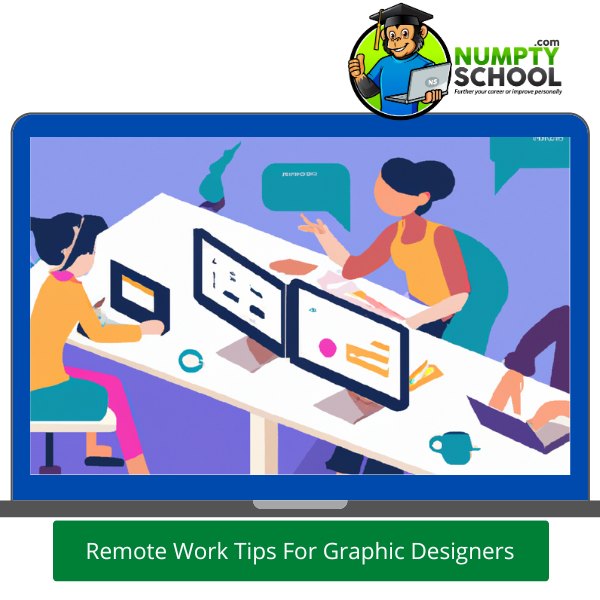Remote Work Tips For Graphic Designers – For Success

Introduction to Remote Work for Designers
The world of graphic design has increasingly embraced remote work, offering designers the freedom to create from anywhere. This flexibility can lead to greater productivity and satisfaction, but it also demands a higher degree of self-discipline and organizational skills. Designers must navigate the nuances of communication, maintain creativity, and ensure the delivery of high-quality work without the traditional office structure.
Benefits of Remote Work
Remote work allows graphic designers to tailor their work environment to their preferences, which can significantly boost creativity and efficiency. The elimination of commuting provides more time for work or personal activities, leading to a better work-life balance. Additionally, the global reach of remote work opportunities can lead to more diverse projects and client bases.
Challenges of Remote Work
Despite its benefits, remote work can sometimes lead to feelings of isolation and disconnect from colleagues and clients. The overlap between personal and professional spaces may lead to longer work hours and difficulty in separating work from personal life. Moreover, remote designers face the challenge of staying updated with the latest trends and technologies without the direct influence of a collaborative office environment.
Setting Up for Success
Designing Your Workspace
A well-organized and inspiring workspace is key to a remote designer’s success. This space should be quiet, well-lit, and separate from personal areas to help delineate work from leisure time. Incorporating elements that inspire creativity, such as art, plants, or a mood board, can also enhance productivity.
Essential Tools and Software
- Collaboration Tools: Tools like Slack for communication, Trello for project management, and Zoom for meetings are indispensable for staying connected with clients and teams.
- Design Software: Mastery of design software such as Adobe Creative Suite, Sketch, and Canva is essential. Subscription to updated software ensures access to the latest features and tools.
Best Practices for Remote Graphic Designers
Time Management Tips
Implementing a structured schedule, utilizing time management apps like Pomodoro timers, and setting clear goals for each day can help manage workload effectively. Regular breaks are also vital to prevent burnout and maintain productivity.
Communication Strategies
Effective communication involves regular updates and check-ins with clients and team members. Utilizing project management tools to track progress and deadlines ensures everyone is on the same page.
Staying Inspired and Creative
To stay inspired, graphic designers can explore online design communities, participate in webinars, and follow industry leaders on social media. Experimenting with new styles and personal projects can also fuel creativity.
Health and Well-being
Physical Health Tips
Investing in an ergonomic chair, ensuring proper lighting, and taking frequent breaks to stretch can mitigate the physical downsides of prolonged desk work.
Mental Health Strategies
Setting clear boundaries between work and personal time, engaging in hobbies outside of work, and maintaining social connections are crucial for mental health.
Building and Maintaining Relationships
With Clients
Transparency, reliability, and regular communication are fundamental in building trust with clients. Providing updates and being responsive to feedback demonstrates professionalism and commitment.
With Teammates
For team cohesion, engage in regular virtual meetups and collaborative brainstorming sessions. Social interactions, even if virtual, can strengthen team dynamics and morale.
Conclusion
Thriving as a remote graphic designer requires a balance of discipline, creativity, and self-care. By adopting effective work practices, designers can not only meet the demands of their roles but also find fulfillment in their work-from-anywhere lifestyle.
FAQs
Q) What are the best tools for remote graphic designers?
A) The best tools include design software like Adobe Creative Suite and Sketch, collaboration platforms like Slack and Trello, and communication apps like Zoom. It’s also beneficial to explore tools specific to your niche within graphic design.
Q) How can I maintain creativity while working remotely?
A) Maintain creativity by setting aside time for personal projects, seeking inspiration through online communities and social media, and continuously learning new techniques or software. Taking regular breaks and changing your work environment can also spark creativity.
Q) What strategies can help manage client relationships remotely?
A) Effective strategies include setting clear expectations from the outset, maintaining open and regular communication, and being transparent about progress and any challenges that arise. Utilizing project management tools to share updates and deadlines can also enhance transparency and trust.
Q) How can I ensure physical and mental health while working from home?
A) For physical health, invest in ergonomic office equipment, take regular breaks, and incorporate physical activity into your daily routine. For mental health, establish a clear work-life boundary, stay connected with friends and colleagues, and engage in activities that relax and rejuvenate you.
Q) What are effective communication strategies for remote teams?
A) Effective communication strategies include regular team meetings, clear documentation of work processes and expectations, and the use of collaborative tools to ensure everyone is informed about project statuses and changes. Encouraging open dialogue and feedback can also foster a more connected and responsive team environment.



